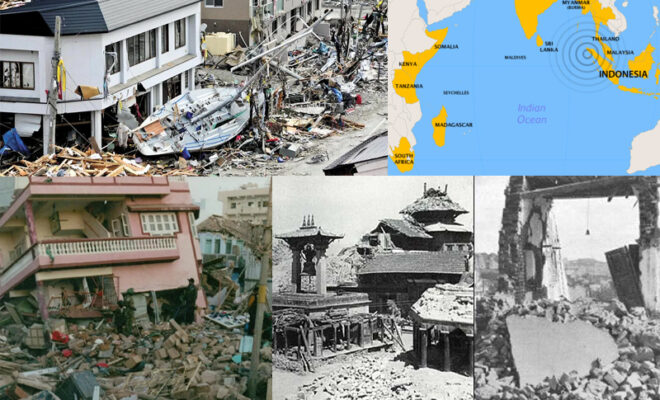Top 10 strongest earthquakes in India

The combined death toll from massive earthquakes that jolted Turkey and neighbouring Syria a couple of weeks back has crossed 47,000. Experts have raised concerns over another humanitarian disaster striking the quake-hit nations as millions of survivors are left homeless and struggling for basic necessities, including safe drinking water, shelter, and medical supplies.
Amid the chaos, a number of experts have now raised alarms over another powerful tremor rattling the Indian state of Uttarakhand anytime as a lot of stress is building up beneath the surface. Although one cannot predict the exact date and time of the quake, the magnitude of the disaster depends on a number of factors, including geographic area, construction quality, and population.
Nevertheless, quakes are no exception in India. The country has already seen a number of them in the past. Read on for a concise list of the ten deadliest earthquakes in India’s history.
10) Assam Earthquake, 1897
Magnitude: 8.1
Epicenter: Exact location not known
Death Toll: 1,500
The quake affected India, Tibet, and Burma, and caused catastrophic damage to infrastructures. States like Assam, Arunachal Pradesh, Gujarat, and Jammu and Kashmir are likely the most prone to earthquakes, considering they fall under Zone 5 – the highest-risk area.
9) Kangra Earthquake, 1905
Magnitude: 7.8
Epicenter: Himalayas
Death Toll: Over 20,000
The Kangra region of Himachal Pradesh witnessed one of the deadliest quakes in India’s pre-independence era on April 4, 1905. While more than 100,000 homes were destroyed in the disaster, scores of animals, trees, and the area’s natural vegetation also faced wrath.
8) Bihar Earthquake, 1934
Magnitude: 8.7
Epicenter: South of Mount Everest
Death Toll: Over 30,000
The quake brought widespread destruction. Similar to the Pokhara earthquake in 2015, the Bihar earthquake ravaged both Nepal and India, though on a much larger scale.
7) Assam Earthquake, 1950
Magnitude: 8.6
Epicenter: Rima, Tibet
Death Toll: 1,526
Several parts of Assam and Tibet suffered major damage in an earthquake that, unfortunately, struck on the Independence Day of India. After the tremors ceased playing their roles, there was substantial flooding that added additional misery to the already scary situation.
6) Koynanagar Earthquake, 1967
Magnitude: 6.5
Epicenter: Koyna
Death Toll: 180
As many as 20 known earthquakes have occurred in Koynanagar – one of the most seismically active areas in India – with the latest one in 2014. More than 1,500 people are known to have suffered injuries in the 1967 quake.
5) Uttarkashi Earthquake, 1991
Magnitude: 6.8
Epicenter: Garhwal, Uttarakhand
Death Toll: Over 1,000
Many civilians were injured, lots of survivors became homeless, nearly 42,000 homes were destroyed or severely damaged, and more than 1,300 villages were devastated in the quake.
4) Latur Earthquake, 1993
Magnitude: 6.4
Epicenter: Killari, Latur
Death Toll: Over 9,500
Maharashtra faced one of the most fatal natural disasters in its history on September 30, 1993. Although the magnitude recorded wasn’t that high – when compared to some entries to this list – the destruction the quake caused was massive.
3) Gujarat Earthquake, 2001
Magnitude: 7.7
Epicenter: Kutch, Gujarat
Death Toll: 20,000
The destruction was so massive that it took more than six months and rigorous relief efforts from all over the world to restore normalcy. While some lost their life savings in the quake, some lost their lives.
2) Indian Ocean Earthquake, 2004
Magnitude: 9.1 – 9.3
Epicenter: West coast of Sumatra, Indonesia
Death Toll: Over 280,000 (Figure addresses deaths in India, Indonesia, Sri Lanka, Thailand, Maldives, and Somalia)
This calamity caused extreme widespread destruction just a day after Christmas. The tremor was powerful enough to submerge numerous islands in the middle of the Indian Ocean.
1) Kashmir Earthquake, 2005
Magnitude: 7.6
Epicenter: Muzaffarabad, Pakistan-administered Kashmir
Death Toll: 130,000
Compared to India, the Pakistani side suffered a relatively more massive loss of life and property. The international community rushed in to lend a helping hand. The Indian Army helped clear the debris, distribute relief supplies and maintain medical camps in both India and Pakistan.
Also Read:- World Should Learn From India’s Digital Payment Systems: IMF



